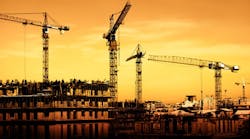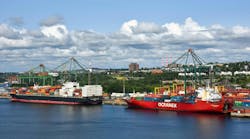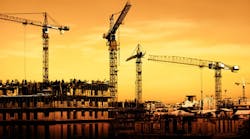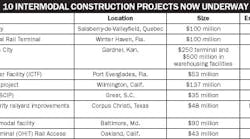While the overall construction market is recovering slowly from the recession, at least one niche exists where the business opportunities are downright exciting.
In port cities throughout North American and at inland transportation hubs, the new construction of intermodal facilities that handle the transfer of shipping containers from ships to railcars, or from railcars to trucks appears to be booming. While it’s tough to get an exact dollar number for the construction contracts related to these projects, the business wires are loaded with reports of the expansion and modernization of intermodal facilities. For an electrical manufacturer, distributor or rep, the sheer amount of electrical and electronic equipment on the purchase orders for these projects is a sight for sore eyes.
Some of this construction is probably due to the improving economic conditions in the overall economy, and intermodal facilities might just be feeling the love of the increased flow of goods through ports and onto North America’s rails and roads. This commerce has always been a good measure of the economy’s health.
But a fair amount of the expansion of intermodal facilities can be linked directly to the new generation of giant container ships that will soon be reaching North America’s shores. When the expansion of the Panama Canal is completed in 2015, superships from Pacific Rim countries and elsewhere will start sailing to be able reach U.S. ports, and if a port can’t accommodate these ships, they will sail to one that does.
These mammoth ships will dwarf most existing container ships. For instance, one of these ships, the 1,300-foot long Marco Polo, is larger than an aircraft carrier and carries 16,000 standard container units or TEUs (twenty-foot equivalent units). Some of the new ships will carry up to 20,000 TEUs. Only ships carrying 5,000 TEUs or less currently fit through the Panama Canal’s locks.
To move the increased freight load that these cargo ships will bring, ports including New York-New Jersey; Baltimore, Md.; Norfolk-Newport News, Va.; Charleston, S.C.; Corpus Christi, Texas; Los Angeles-Long Beach; and Oakland, Calif.; all have major construction projects underway right now to dredge harbor channels and increase the size of their docks, or to expand their container-handling capabilities.
Once these ships pull into port, giant ship-to-shore cranes pick the shipping containers off the ships and place them either onto a railcar, truck bed or into temporary storage. These cranes are connected to highly automated control centers with miles of power, control or fiber-optic cable; industrial controls and related automation equipment; and the overall docking facilities are loaded with lighting, general power systems, transformers, distribution equipment and utility equipment.
In addition to the control systems that operate the giant gantry cranes big enough to tower over a container ship or several rail lines, there’s also quite a bit of control communications work on the freight lines and locomotives themselves because of a federal safety regulation that requires the installation of positive train control (PTC) systems by the end of Dec. 2015. According to the American Association of Railroads (AAR), PTC is a communications system designed to automatically stop or slow a train before certain accidents occurs, and it must be deployed on approximately 63,000 miles of U.S. freight rail lines. These PTC communications systems require wireless communications, global positioning and cell networks. Says AAR, “This will involve the installation of PTC capability on thousands of locomotives; a large, new wireless communications network and tens of thousands of track-side devices connected to signals, switches and other wayside devices.”
Yet another key factor creating sales opportunities for electrical companies is the fact that more intermodal shipping containers are now being hauled by freight trains instead of trucks because they can do so much more efficiently. As a result, there’s been a surge on construction of the intermodal facilities that handle the transfer of freight from trains to trucks for local delivery (see chart on this page).
Trains can move a ton of freight about 500 miles on a single gallon of fuel, and one train can carry the load of 280 trucks, according to the U.S. Department of Transportation. Because they are moving more containers, railroads are building these intermodal facilities and renovating their freight lines so they can double-stack these containers, which has a ripple effect all along the supply chain. This requires retrofitting loading/unloading facilities to accommodate the taller trains and in many cases requires new bridges over freight lines because the old bridge aren’t tall enough for the double-stacked trains.
This is part of the challenge confronting the CSX railroad company in its $850 million National Gateway project linking Baltimore and other East Coast ports to the Midwest. CSX is building this project with $275 million in federal funding. According to www.nationalgateway.org, “The National Gateway is a double stack cleared, state-of-the-art rail corridor linking the East Coast’s international deepwater ports and major consumption markets with the population and manufacturing centers of the Midwest. With improved clearances, new terminals and greater capacity, the National Gateway will improve the flow of freight, enhancing consumer options and augmenting the Midwest’s ability to deliver manufactured goods to world markets.”
The impact of the move to intermodal rail shipments extends far from coastal ports. Part of National Gateway project was an intermodal facility completed in 2011 in North Baltimore, Ohio, where Jess Howard Electric, Blacklick, Ohio, won a $13 million contract that required 20 electricians to install more than 50 miles of fiber-optic cable, 35 miles of conduit encased in concrete, site lighting and CCTV security systems.
The growth of this market has caught the attention of several electrical companies. As previously reported in Electrical Marketing, Turtle and Hughes, Inc., Linden, N.J., recently acquired industrial automation specialist Mag-Trol Long Beach Inc., Long Beach, Calif., adding to a niche of providing electrical products for seaport expansion it had previously developed through its Houston location. In business since 1981, Mag-Trol Long Beach is a specialist in harbor applications, providing motion control, programmable logic controllers (PLC’s), sensing and other industrial automation technologies along with renewal parts and value-added services.
Another company that’s already a huge player in intermodal work is ABB. The company is one of the largest manufacturers of the giant gantry cranes used to unload container ships, and last month a Cary, N.C.-based ABB business unit announced plans to acquire San Diego-based APS Technology Group (APS) to add optical character recognition (OCR) and gate automation capabilities to further improve safety, productivity and efficiency of port operations as containerized shipping grows worldwide.
According to the press release announcing the acquisition, APS, is an 11-year-old, 50-person company with offices in San Diego and Long Beach, Calif., and will join ABB’s Crane and Harbor automation business. “As containerized shipping grows, container handling in ports and terminals is quickly moving away from manual controls to fully automated systems,” Fred Hoonaard, head of Crane and Harbor Center of Excellence,” said in the release.
ABB’s Crane and Harbor business unit headquartered in Sweden has 1,000 employees in 19 countries. It makes a wide range of electrical products, including medium-voltage distribution equipment, transformers, low-voltage distribution equipment, AC and DC drives, power-factor compensation equipment, sensors and video systems. These projects can be massive. Several years ago it installed 76 container cranes in Euromax, a 3 million TEU container terminal at the port of Rotterdam. ABB also provides a range of automation and electric grid products and services to marine industries, including shore-to-ship electric power for idling ships’ engines at ports to lower cost and emissions.
How big is the opportunity in this niche? On the port side of things, ABB estimates that the global terminal automation market will double in five years. Apparently, ABB has a good head start on other manufacturers that may contemplate getting into this market. The company says it has already delivered automation systems to more than half the world’s automated container terminals.











